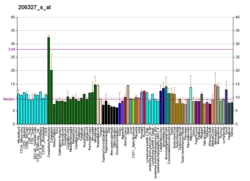CDH15
Cadherin-15 is a protein that in humans is encoded by the CDH15 gene.[5][6]
Function
This gene is a member of the cadherin superfamily of genes, encoding calcium-dependent intercellular adhesion glycoproteins. Cadherins consist of an extracellular domain containing 5 cadherin domains, a transmembrane region, and a conserved cytoplasmic domain. Transcripts from this particular cadherin are expressed in myoblasts and upregulated in myotubule-forming cells. The protein is thought to be essential for the control of morphogenetic processes, specifically myogenesis, and may provide a trigger for terminal muscle cell differentiation.[6]
Interactions
References
- 1 2 3 GRCh38: Ensembl release 89: ENSG00000129910 - Ensembl, May 2017
- 1 2 3 GRCm38: Ensembl release 89: ENSMUSG00000031962 - Ensembl, May 2017
- ↑ "Human PubMed Reference:".
- ↑ "Mouse PubMed Reference:".
- ↑ Kaupmann K, Becker-Follmann J, Scherer G, Jockusch H, Starzinski-Powitz A (December 1992). "The gene for the cell adhesion molecule M-cadherin maps to mouse chromosome 8 and human chromosome 16q24.1-qter and is near the E-cadherin (uvomorulin) locus in both species". Genomics. 14 (2): 488–90. doi:10.1016/S0888-7543(05)80247-2. PMID 1427864.
- 1 2 "Entrez Gene: CDH15 cadherin 15, M-cadherin (myotubule)".
- ↑ Kaufmann U, Zuppinger C, Waibler Z, Rudiger M, Urbich C, Martin B, Jockusch BM, Eppenberger H, Starzinski-Powitz A (November 2000). "The armadillo repeat region targets ARVCF to cadherin-based cellular junctions". J. Cell Sci. 113 (22): 4121–35. PMID 11058098.
Further reading
- Donalies M, Cramer M, Ringwald M, Starzinski-Powitz A (1991). "Expression of M-cadherin, a member of the cadherin multigene family, correlates with differentiation of skeletal muscle cells". Proc. Natl. Acad. Sci. U.S.A. 88 (18): 8024–8. doi:10.1073/pnas.88.18.8024. PMC 52438. PMID 1840697.
- Bornemann A, Schmalbruch H (1994). "Immunocytochemistry of M-cadherin in mature and regenerating rat muscle". Anat. Rec. 239 (2): 119–25. doi:10.1002/ar.1092390202. PMID 8059975.
- Shibata T, Shimoyama Y, Gotoh M, Hirohashi S (1997). "Identification of human cadherin-14, a novel neurally specific type II cadherin, by protein interaction cloning". J. Biol. Chem. 272 (8): 5236–40. doi:10.1074/jbc.272.8.5236. PMID 9030594.
- Kuch C, Winnekendonk D, Butz S, Unvericht U, Kemler R, Starzinski-Powitz A (1997). "M-cadherin-mediated cell adhesion and complex formation with the catenins in myogenic mouse cells". Exp. Cell Res. 232 (2): 331–8. doi:10.1006/excr.1997.3519. PMID 9168809.
- Shimoyama Y, Shibata T, Kitajima M, Hirohashi S (1998). "Molecular cloning and characterization of a novel human classic cadherin homologous with mouse muscle cadherin". J. Biol. Chem. 273 (16): 10011–8. doi:10.1074/jbc.273.16.10011. PMID 9545347.
- Kremmidiotis G, Baker E, Crawford J, Eyre HJ, Nahmias J, Callen DF (1998). "Localization of human cadherin genes to chromosome regions exhibiting cancer-related loss of heterozygosity". Genomics. 49 (3): 467–71. doi:10.1006/geno.1998.5281. PMID 9615235.
- Shimoyama Y, Tsujimoto G, Kitajima M, Natori M (2001). "Identification of three human type-II classic cadherins and frequent heterophilic interactions between different subclasses of type-II classic cadherins". Biochem. J. 349 (Pt 1): 159–67. doi:10.1042/0264-6021:3490159. PMC 1221133. PMID 10861224.
- Kaufmann U, Zuppinger C, Waibler Z, Rudiger M, Urbich C, Martin B, Jockusch BM, Eppenberger H, Starzinski-Powitz A (2001). "The armadillo repeat region targets ARVCF to cadherin-based cellular junctions". J. Cell Sci. 113 (22): 4121–35. PMID 11058098.
- Meigs TE, Fields TA, McKee DD, Casey PJ (2001). "Interaction of Galpha 12 and Galpha 13 with the cytoplasmic domain of cadherin provides a mechanism for beta -catenin release". Proc. Natl. Acad. Sci. U.S.A. 98 (2): 519–24. doi:10.1073/pnas.021350998. PMC 14619. PMID 11136230.
- Hollnagel A, Grund C, Franke WW, Arnold HH (2002). "The cell adhesion molecule M-cadherin is not essential for muscle development and regeneration". Mol. Cell. Biol. 22 (13): 4760–70. doi:10.1128/MCB.22.13.4760-4770.2002. PMC 133893. PMID 12052883.
- Kang JS, Feinleib JL, Knox S, Ketteringham MA, Krauss RS (2003). "Promyogenic members of the Ig and cadherin families associate to positively regulate differentiation". Proc. Natl. Acad. Sci. U.S.A. 100 (7): 3989–94. doi:10.1073/pnas.0736565100. PMC 153035. PMID 12634428.
External links
- CDH15 human gene location in the UCSC Genome Browser.
- CDH15 human gene details in the UCSC Genome Browser.
- Human CDH3 genome location and CDH3 gene details page in the UCSC Genome Browser.
This article is issued from
Wikipedia.
The text is licensed under Creative Commons - Attribution - Sharealike.
Additional terms may apply for the media files.





